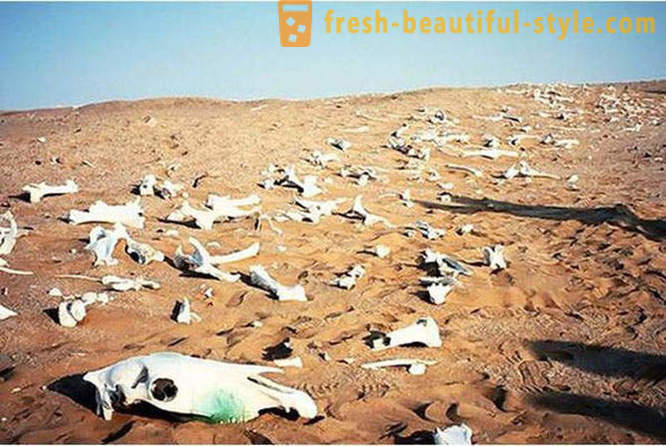5 most mass extinctions of animals
The rapid disappearance of many species of mammals today can be a sign of impending sixth mass extinction in Earth's history, but the situation is still not too late to "expand", scientists report in an article that was published in the journal Nature. However, until this world has gone through as many as five such accidents. Let's see how and where it was.

1. The Ordovician-Silurian extinction events

The very first mass extinction occurred about 450-440 million. Years ago. it is impossible to name the exact cause of the extinction, but most scholars are inclined to believe that the reason was the movement of Gondwana - huge supercontinent that included almost all the Earth's land.
And all because of Gondwana - the giant continent, from which it then "hatched" and Africa, and South America, and Australia, and Antarctica - hove to and went exactly to the South Pole. Water boundaries have changed, and with them, and the usual ranges of all kinds of brachiopods and mollusks. It ended as all global cooling - water and land. The fact that today is the Sahara Desert, was then solid glacier. Ice significantly changed the terrain: the water level in the ocean has fallen sharply. In short, 60% of marine invertebrates to pass on their genes and could not.
2. Late Devonian extinction

There was 374 and 359 million. Years ago. Devonian extinction consisted of two peaks, during which the Earth lost 50% of the existing genera and almost 20% of all families. During the Devonian extinction disappeared almost all jawless (up to the present day survived only lampreys and hagfish). Extinction accompanied by widespread oceanic anoxia, ie the lack of oxygen, which prevented rotting organisms and predispose to the preservation and accumulation of organic matter. This effect, in combination with the ability to hold the sponge reef stones oil allowed Devon stones to be an important source of oil, particularly in the United States.
3. The great Permian extinction

The most mass extinction ever happen on our planet. Some scientists call the Permian extinction - the greatest mass extinction of all time. Around 250 million. Years ago, disappeared 70% of all land animals. In the ocean, it fared even worse - killed 96% of marine species. During the Great Permian extinction killed more than 57% of births and 85% of species of insects. This is the only known extinction, which affected insects.
In view of the loss of such a large number and variety of species of the biosphere recovery took much longer period of time compared to other disasters, leading to extinction.
After the Permian extinction fauna recovered 30 million. Years (some scientists believe that the biosphere restoration lasted 5 million. Years). Widespread animals that have been in the shadow of more powerful forms. So, this time, is a period of formation of archosaurs (the ancestors of modern crocodiles and extinct dinosaurs). Descended from them and poultry, which could have been avoided if not for the great Permian extinction.
4. The Triassic-Jurassic extinction event

Triassic-Jurassic extinction event happened 200 million. Years ago. Lost about 20% of all marine animals, many archosaurs (became widespread after the Permian extinction), and most species of amphibians. Scientists estimate that half of all known animals that lived at the time, died during the Triassic extinction.
A feature of the Triassic extinction is considered short-termism. It happened over 10 thousand. Years, which is very fast on a planetary scale. At this time it began to disintegrate sverhkontinenta Pangea into separate continents. It is possible that the cause of the collapse was the largest asteroid to change the weather on the planet, causing the extinction. But the evidence for this theory is not so far found no large crater triarskogo period.
Today in science several versions of what happened spread extinction. Is the most common hypothesis on t. N. "Metangidratnom gun", which is the most plausible. Because of volcanic and accumulation of carbon dioxide in the atmosphere, I began released in large quantities of methane clathrates bottom. Toxic release this unpleasant greenhouse gas played a part of the trigger for a sharp global warming, and that destabilized the climate of the planet and caused the total Achtung.
5. The Cretaceous-Paleogene extinction event

The most famous extinction occurred about 65 million. Years ago. It is famous for the fact that at this time on the Earth dinosaurs. Also killed more than 15% of families of marine mammals and 18% of families of terrestrial animals. It offers a variety of explanations - from the fantastic (the dinosaurs wiped out hunting for them little green men in flying saucers), and to a very plausible (climate change destroy their ecological niche). The most famous theory is that the Earth collided with a large asteroid or a hit in the radiation zone of the supernova explosion.
The most interesting explanation links the extinction of the dinosaurs with the emergence of flowering plants that have occurred, is believed to be 65 million years ago - just when the dinosaurs disappeared. The point is that before the dinosaurs ate mainly pine needles and the like with food, rich in natural oils, and when they had to switch on the grass, they all died of constipation!
Another very interesting theory that they were exterminated by the first mammal, which destroyed the dinosaurs masonry, preventing them from multiplying. This is supported by the fact that some dinosaurs lived quite a long time on the territory of present-day North America and India, where possible, of "dangerous" mammals appeared later.













































